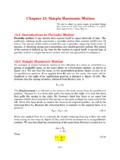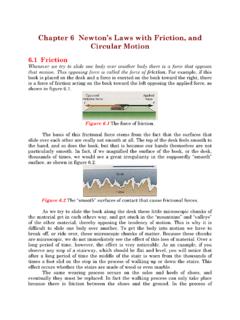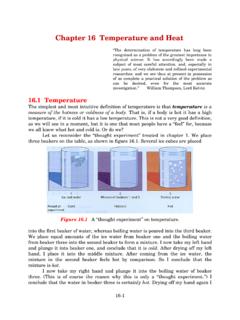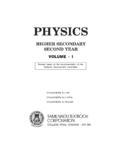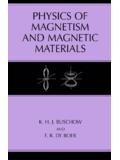Transcription of Chapter 22: Electric Flux and Gauss’s Law - …
1 Introduction We have seen in Chapter 21 that determining the Electric field of a continuouscharge distribution can become very complicated for some charge distributions. Itwould be desirable if we could find a simpler way to determine the Electric field of acharge distribution. It turns out that if a certain symmetry exists in the chargedistribution it is possible to determine the Electric field by means of gauss s law . Tounderstand gauss s law we must first understand the concept of Electric Electric flux flux is a q uantitative measure of the numb er of lines of a vector field that passesperpendicularly through a surface. Figure , shows an Electric field E passingthrough a portion of a surface of area A. The area of the surface is represented by avector A, whose magnitude is the area A of the surface, and whose direction isperpendicular to the surface.
2 That an area can be represented by a vector wasshown in Chapter 3. The Electric flux is defined to be ( ) E=E*A=EAcos and is a quantitative measure of the number of lines of E that pass normally throughthe surface area A. The number of lines represents the strength of the field. Thevector E, at the point P of figure (a), can be resolved into the components, E the component perpendicular to the surface, and E|| the parallel component. Theperpendicular component is given byE = E cos ( )while the parallel component is given by E|| = E sin ( )The parallel component E|| lies in the surface itself and therefore does not passthrough the surface, while the perpendicular component E completely passesthrough the surface at the point P.
3 The product of the perpendicular component E and the area A E A = (E cos )A = EA cos = E A = E ( )is therefore a quantitative measure of the number of lines of E passing normallythrough the entire surface area A. If the angle in equation is zero, then E isparallel to the vector A and all the lines of E pass normally through the surfaceChapter 22: Electric flux and gauss s Law22-1 xyzPA E EExyzPAE (a) (b) xyzPAEE(c) Figure Electric A, as seen in figure (b). If the angle in equation is 900 then E isperpendicular to the area vector A, and none of the lines of E pass through thesurface A as seen in figure (c).
4 The concept of flux is a very important one, andone that will be used frequently later. Example flux . An Electric field of 500 V/m makes an angle of with the surfacevector, which has a magnitude of m2. Find the Electric flux that passesthrough the surface. SolutionThe Electric flux passing through the surface is given by equation as Chapter 22: Electric flux and gauss s Law22-2 E = E A = EA cos E = (500 V/m)( m2) E = 217 V mNotice that the unit of Electric flux is a volt times a go to this Interactive Example click on this gauss s law for Electricity It was pointed out in section that an Electric flux was a quantitative measure ofthe number of Electric field lines passing normally through an area. The Electric fluxwas illustrated in figure and defined in equation as E = E A = EA cos ( )Let us now consider the amount of Electric flux that emanates from a positivepoint charge.
5 Figure shows a positive point charge surrounded by an imaginaryspherical surface called a Gaussian surface. Let us measure the amount of electricflux through the sphere. The direction of the E field is different at every point,however, so equation can not be used in its present form. Instead, the spherical+qEEEEEEEEdAE(a)(b)Figure gauss s law for is broken up into a large number of infinitesimal surface areas dA, (b), and the infinitesimal amount of flux d E through each of these little areasis computed, , Chapter 22: Electric flux and gauss s Law22-3d E = E dA ( )The total flux out of the Gaussian surface becomes the sum or integral of all theinfinitesimal fluxes d E, through all the infinitesimal areas dA, that is ( ) E= d E= E*dAThe integral symbol means that the integration is performed over the entire closed surface that the flux is passing through.
6 The Electric vector E is everywhereradial from the point charge q, and dA is also everywhere radial, hence ( ) E= E*dA= EdAcos 00 Thus, ( ) E= EdABut it was found in Chapter 21 that the Electric field of a point charge was given byequation asE = kq/r2 ( )Substituting the Electric field of a point charge, from equation , into , we get for the Electric flux through the spherical surface ( ) E= kqr2dAwhere r is the radius of the spherical Gaussian surface, and for that sphere it is aconstant. The terms k and q are also constants and they can, therefore, be takenoutside of the integral sign. Thus, ( ) E=kqr2 dABut the integral of all the elements of area dA is equal to the entire surface area ofthe sphere.
7 Since the surface area of a sphere is 4 r2, we have dA=4 r2 Thus, the Electric flux emanating from a point charge becomes ( ) E=kqr24 r2 ( ) E=14 oqr24 r2 where use has been made of the fact that k in equation is equal to 1/(4 o).Hence, the Electric flux associated with a point charge isChapter 22: Electric flux and gauss s Law22-4 ( ) E=q oEquation is gauss s law for electricity, and it says that the Electric flux E thatpasses through a surface surrounding the point charge q is a measure of the amountof charg e q contained w ithin the G aussian surface. Although equation wasderived for a point charge, it is true, in general, for any kind of charge E was initially defined in equation , it can be combined with into the generalization of gauss s law as ( ) E= E*dA=q oWhere q is now the net charge contained within the Gaussian surface.
8 Was derived on the basis of a point charge. If the charge is distributed over avolume V, with a volume charge density , then the charge q can be written as ( )q= dVand gauss s law can also be written as ( ) E= E*dA=1 o dVIf the total charge q within the Gaussian surface is known, gauss s law in the form ofequation can be used. When only the charge density is known, then gauss slaw in the form of equation is used. When E is a positive q uantity, the Gaussian surface surrounds a source ofpositive charge, and Electric flux diverges out of the surface. If the point charge isnegative then the Electric field would go inward, through the Gaussian surface, tothe point charge. The vector E would, therefore, make an angle of 1800 with thearea vectors dA and their dot product would beE dA = E dA cos1800 = E dA Thus, the flux passing through the Gaussian surface would be negative.
9 Hence,whenever E is negative, the Gaussian surface surrounds a negative chargedistribution and the Electric flux converges into the G aussian surface. If there is noenclosed charge, q = 0, and hence, E = 0. In this case, whatever Electric flux entersone part of a Gaussian surface, the same amount must leave somewhere else. Thesedifferent possibilities are shown for an Electric dipole in figure Thus, Gaussiansurface 1 shows the Electric flux diverging from the positive point charge. Gaussiansurface 2 shows the Electric flux converging into the negative point charge, andGaussian surface 3 shows no enclosed charge, and the amount of Electric field Chapter 22: Electric flux and gauss s Law22-5+q-qGaussian surface1 Gaussian surface2 Gaussian surface3 Figure Gaussian surfaces and an Electric normally through the surface is equal to the amount leaving the surfacenormally.
10 Let us now consider some examples of the application of gauss s law todetermine the Electric field of various symmetric charge The Electric Field of a Spherically SymmetricUniform Charge Distribution Figure (a) shows a spherically symmetric distribution of total Electric charge assume that the distribution is uniform over the sphere of radius R and has avolume charge density (C/m3). (a)R+++qR+++qrdAE(b)rRqq'++++(c)ErRo(d) Figure A spherically symmetric distribution of Electric us find the Electric field E at (a) points outside the sphere, that is for r > R and(b) for points inside the sphere, that is for r < R. Chapter 22: Electric flux and gauss s Law22-6(a) The Electric field outside the uniform charge distribution. To determine the Electric field outside the spherical distribution of charge wefirst must draw a Gaussian surface.


